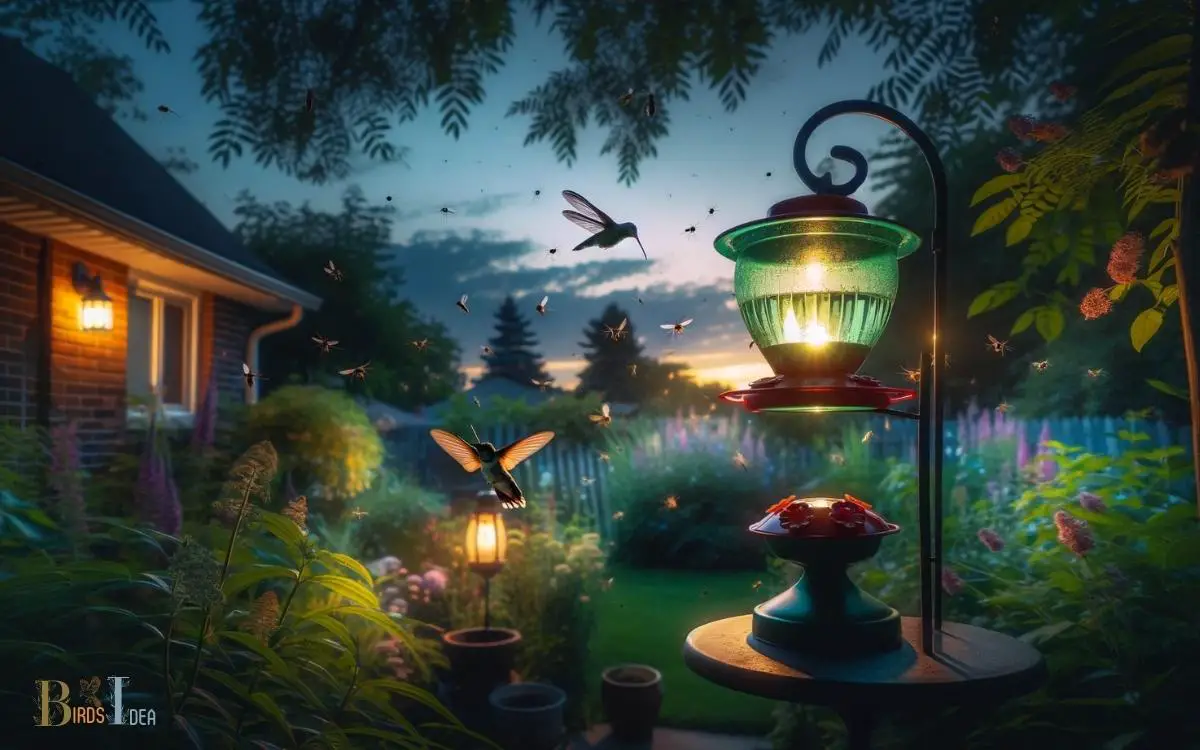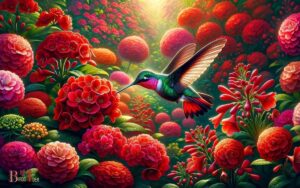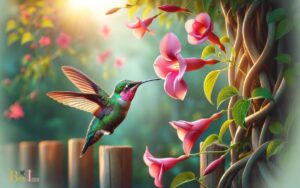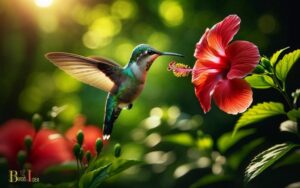Do Hummingbird Feeders Attract Mosquitoes? Yes!
Yes, Hummingbird feeders can attract mosquitoes but not primarily due to the feeders themselves.
Mosquitoes are drawn to standing water where they can lay eggs, and hummingbird feeders may inadvertently provide this if they leak or are not properly maintained.
To enjoy hummingbirds without a mosquito influx, it’s important to take preventive measures such as changing the feeder’s nectar regularly and ensuring there’s no stagnant water around.
Mosquitoes are attracted to areas that provide suitable conditions for breeding, which include stagnant water.
Here are some tips to prevent mosquitoes around hummingbird feeders:
- Regularly clean and refill feeders to prevent nectar from fermenting.
- Check for leaks and repair any that are found.
- Eliminate any standing water in the vicinity of the feeders.
Enjoy the charm of hummingbirds at your feeder without the nuisance of mosquitoes by ensuring proper maintenance and cleanliness.

Key Takeaway
Effective Methods to Prevent Mosquitoes Around Hummingbird Feeders
| Prevention Method | Description | Frequency |
|---|---|---|
| Clean and Refill Feeders | Change nectar regularly to avoid fermentation. | Every 2-3 days |
| Repair Leaks | Fix leaks to prevent water accumulation. | As needed |
| Remove Standing Water | Eliminate any puddles or standing water near feeders. | After rain/weekly |
| Proper Feeder Placement | Place feeders away from low-lying areas prone to water accumulation. | When setting up |
| Use Mosquito Dunks | Consider adding non-toxic mosquito dunks in water features. | Monthly/as per product instructions |
Understanding Mosquito Behavior
Mosquitoes are attracted to certain environmental cues when seeking sources of food. These cues include carbon dioxide, body heat, and certain chemicals found in human sweat.
Female mosquitoes, which are the ones that bite, use these cues to locate hosts for a blood meal necessary for egg production.
In addition to these cues, visual and olfactory stimuli also play a role in guiding mosquitoes towards their targets.
Studies have shown that mosquitoes have a preference for certain colors, such as black, dark blue, and red, and are attracted to the odors produced by human skin bacteria.
Understanding these behaviors is crucial in developing effective strategies to control mosquito populations and reduce the risk of mosquito-borne diseases for humans and animals.
Factors Influencing Mosquito Attraction
Several factors can influence mosquito attraction to hummingbird feeders.
Here are some key factors:
Sweetness of Nectar
Mosquitoes are attracted to the sweetness of nectar in hummingbird feeders. Hummingbird feeders typically contain a sugary solution to mimic the natural nectar hummingbirds consume. This sweetness can also attract mosquitoes seeking a sugar source.
Stagnant Water
Mosquitoes breed in stagnant water, and if there is any standing water around or inside the hummingbird feeder, it can become a breeding ground for mosquitoes. Regular cleaning and maintenance of the feeder can help prevent this.
Color and Design
Mosquitoes are attracted to certain colors, and the design of the feeder may also influence mosquito activity.
Darker colors, especially red, can attract mosquitoes. Consider choosing feeders with less appealing colors to mosquitoes.
Carbon Dioxide Emission
Mosquitoes are attracted to carbon dioxide, which is released when animals and humans exhale.
If the feeder is placed near areas where people gather, mosquitoes may be drawn to the carbon dioxide emitted by humans.
Temperature and Humidity
Mosquitoes are more active in warm and humid conditions. If the environment around the hummingbird feeder is warm and humid, it may enhance mosquito activity. This is beyond the control of the feeder itself but can still influence mosquito presence.
Proximity to Vegetation
Mosquitoes often rest in vegetation and shaded areas during the day. If the hummingbird feeder is located close to dense vegetation, it may provide resting spots for mosquitoes, increasing the likelihood of their presence.
To minimize mosquito attraction, it’s advisable to clean and maintain the feeder regularly, choose feeders with less attractive colors, and place them in areas with good airflow and away from stagnant water.
Additionally, consider using mosquito repellents or natural deterrents in the surrounding area.
Impact of Hummingbird Feeders on Mosquitoes
Attracting mosquitoes through their sensitivity to environmental cues, hummingbird feeders have been a subject of inquiry regarding their potential impact on mosquito populations.
Some believe that the sugar water in hummingbird feeders may attract mosquitoes, potentially increasing their numbers in the vicinity. However, scientific research on this topic is limited.
Here is a table illustrating the potential impact of hummingbird feeders on mosquitoes:
| Impact of Hummingbird Feeders on Mosquitoes | Description |
|---|---|
| Attraction | Mixed evidence exists regarding mosquito attraction to sugar water. Some studies suggest minimal attraction, while others indicate a potential increase in mosquito presence. |
| Population Control | There is no scientific consensus on whether hummingbird feeders contribute to mosquito population control. More research is needed to understand the potential impact. |
| Disease Transmission | There is no direct evidence linking hummingbird feeders to increased disease transmission by mosquitoes. Proper maintenance and cleaning can mitigate potential risks. |
| Ecological Impact | The ecological impact of hummingbird feeders on mosquito populations has not been extensively studied. Further research is necessary to evaluate any potential ecological consequences. |
Tips for Minimizing Mosquito Presence
To minimize mosquito presence around hummingbird feeders, implementing proper maintenance and cleaning practices is essential.
Mosquitoes are attracted to standing water and the sugar solution in hummingbird feeders, so it’s crucial to take steps to minimize their presence.
Here are some tips for minimizing mosquito presence:
- Clean the feeder regularly with hot water and soap to remove any sugar residue that could attract mosquitoes.
- Change the nectar solution every few days to prevent it from fermenting and becoming a breeding ground for mosquitoes.
- Place the feeder in a sunny, open area to promote evaporation and discourage mosquito breeding.
Creating a Mosquito-Resistant Environment
Implementing mosquito-resistant measures around hummingbird feeders can help minimize the presence of these insects and create a more enjoyable environment for both the birds and observers.
Creating a mosquito-resistant environment involves strategic planning and implementation of various methods to repel or eliminate mosquitoes.
Here are some effective measures to consider:
| Mosquito-Resistant Measures | Description |
|---|---|
| Remove Standing Water | Eliminate any stagnant water sources where mosquitoes breed, such as birdbaths or clogged gutters. |
| Plant Mosquito-Repellent Plants | Incorporate plants like citronella, marigolds, and lavender around the feeding area to naturally repel mosquitoes. |
| Use Mosquito-Repellent Solutions | Apply EPA-approved mosquito repellents in the surrounding area to discourage mosquito activity. |
Conclusion
While hummingbird feeders ma attract some insects, studies have shown that they do not significantly increase mosquito populations.
According to research conducted by the University of California, only 1-2% of insects captured at hummingbird feeders were mosquitoes.
By following proper maintenance and cleaning techniques, individuals can enjoy the beauty of hummingbirds without experiencing a significant increase in mosquito presence.






